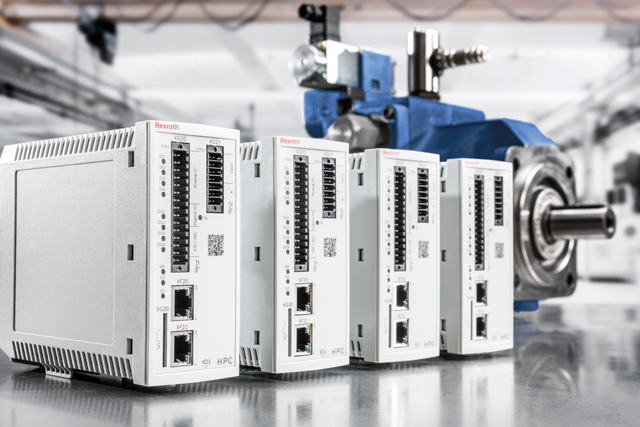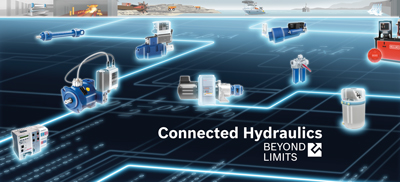 Hybrid hydraulics systems add the sophistication and ease of use of electronic controls for industrial applications. Bosch Rexroth product manager for industrial hydraulics Jake Mitchell explains
Hybrid hydraulics systems add the sophistication and ease of use of electronic controls for industrial applications. Bosch Rexroth product manager for industrial hydraulics Jake Mitchell explains
Hydraulic systems have been established for more than 200 years as an efficient and convenient way of powering a myriad of industrial applications. They remain at the heart of industrial processes over a wide spectrum of sectors.
The advantages of hydraulic systems remain clear. Cost-effective and reliable when compared with the alternatives, the sheer quantity and density of power they can provide mean that in some high-demand applications they are the only option. Highly resistant to impact, vibration and outside influences, they can also fit into tight spaces.
As is the case with any other system in industrial processing, hydraulic products and systems are continually evolving to keep pace with other areas of modernisation, not least as the drive towards Industry 4.0 gathers momentum.
Adoption of Industry 4.0 requires a level of connectedness with other systems, along with the ability to monitor and respond to actual and anticipated performance issues that, in many instances, would not even have been considered 20 years ago. This goes hand in hand with a broader desire among many manufacturers to understand in detail the workings of individual systems, the problems affecting them and best practice in maintenance.
However, it would be wrong to suggest that Industry 4.0 is the only driver of change in the area of hydraulics. In all sectors, pressures on prices combined with rising energy costs require manufacturers to examine all aspects of design and operations to make sure they are as efficient as they can be. Increasingly stringent local, national and international regulation, in areas such as sustainability, environmental practice, and health and safety, require system designers to seek to integrate intelligent components such as smart controllers, sensors and monitoring technologies into their hydraulic systems.
Modern hydraulic systems must be efficient, safe and connected, allowing continuous condition monitoring (and response to changes in condition), while not compromising on their unique ability to provide power. This has led to the development of hybrid or electro-hydraulic solutions which combine the power capabilities of hydraulics with the efficiency, safety and connectivity benefits of electrical and electronic systems.
“Electronification” extends the power capabilities of hydraulic systems by offering the possibility of more sophisticated motion control sequences, so that torque is optimally employed over a range of applications. Drawing on Bernoulli’s law that, in an ideal state, a faster-flowing fluid will exert less pressure, the latest sensors and hydraulic controls make possible improved flexibility and variability in flow and pressure to optimise performance.
Intensive research and development by the leading players in the sector has made software-based automation a real possibility. This means hydraulic systems in many applications can be controlled with exactly the same tools as electric drives, bringing the benefits of hydraulic systems within the scope of design engineers who were previously denied this opportunity by the limits of their knowledge and training.
The latest system solutions for electronified hydraulics employ the same electronic control assemblies and logic as electric drives. Using open standards such as multi-Ethernet interfaces, they can be added to horizontally and vertically networked machine architectures in exactly the same way. An electro-hydraulic axis is put into operation with the same engineering tools as an electric drive, but with two clear distinctions.
First, a “wizard” logically guides the technician through the commissioning of the hydraulic actuator and suggests values for parameters which will lead to the desired result. Second, best-in-class controllers intelligently compensate, in the background, for the special features of fluid technology. The point is that commissioners of systems do not need to have any specific knowledge of hydraulic systems to gain effective results from them. Meanwhile, the latest variable speed pump drives can cut the energy consumption of a hydraulic axis by as much as 80%.
 In recent years almost all motion patterns and special features of fluid technology have been modelled in modular software – even specific characteristics such as transmission kinematics and controlled synchronisation. Distinct online configurators for components and modules are available, with simulation tools checking all components for proper dimensions, and allowing designers to test a wide variety of virtual configurations. Modern solutions are based on distributed intelligence and open standards for programming and communication. Cabinet-free motion controllers can further simplify designs.
In recent years almost all motion patterns and special features of fluid technology have been modelled in modular software – even specific characteristics such as transmission kinematics and controlled synchronisation. Distinct online configurators for components and modules are available, with simulation tools checking all components for proper dimensions, and allowing designers to test a wide variety of virtual configurations. Modern solutions are based on distributed intelligence and open standards for programming and communication. Cabinet-free motion controllers can further simplify designs.
What this means is that the suitability of hydraulics for any application can be evaluated, and the application automated, in the same way as with any other technology.
Digital twins of hydraulic components make possible simulations and software-controlled process changes, while networked hydraulics monitor and detect errors with a probability of 99% before they result in a failure. Specialist sensors can acquire information on various operating conditions in hydraulic power units such as oil quality, temperature and vibration, as well counting the switching cycles of valves, feeding this back in real time to control systems and allowing appropriate precautions to be implemented actively in planned production breaks.
Electronified hydraulics offer unique power density, efficiency and robustness – with system design, parameterisation, commissioning, operation and software-based diagnostics which are just as convenient as for other drive technologies.
With digital intelligence, networkable hydraulics can be seamlessly integrated into multi-technology and Industry 4.0 concepts, meaning they are and will remain a vital component of modern mechanical engineering.

